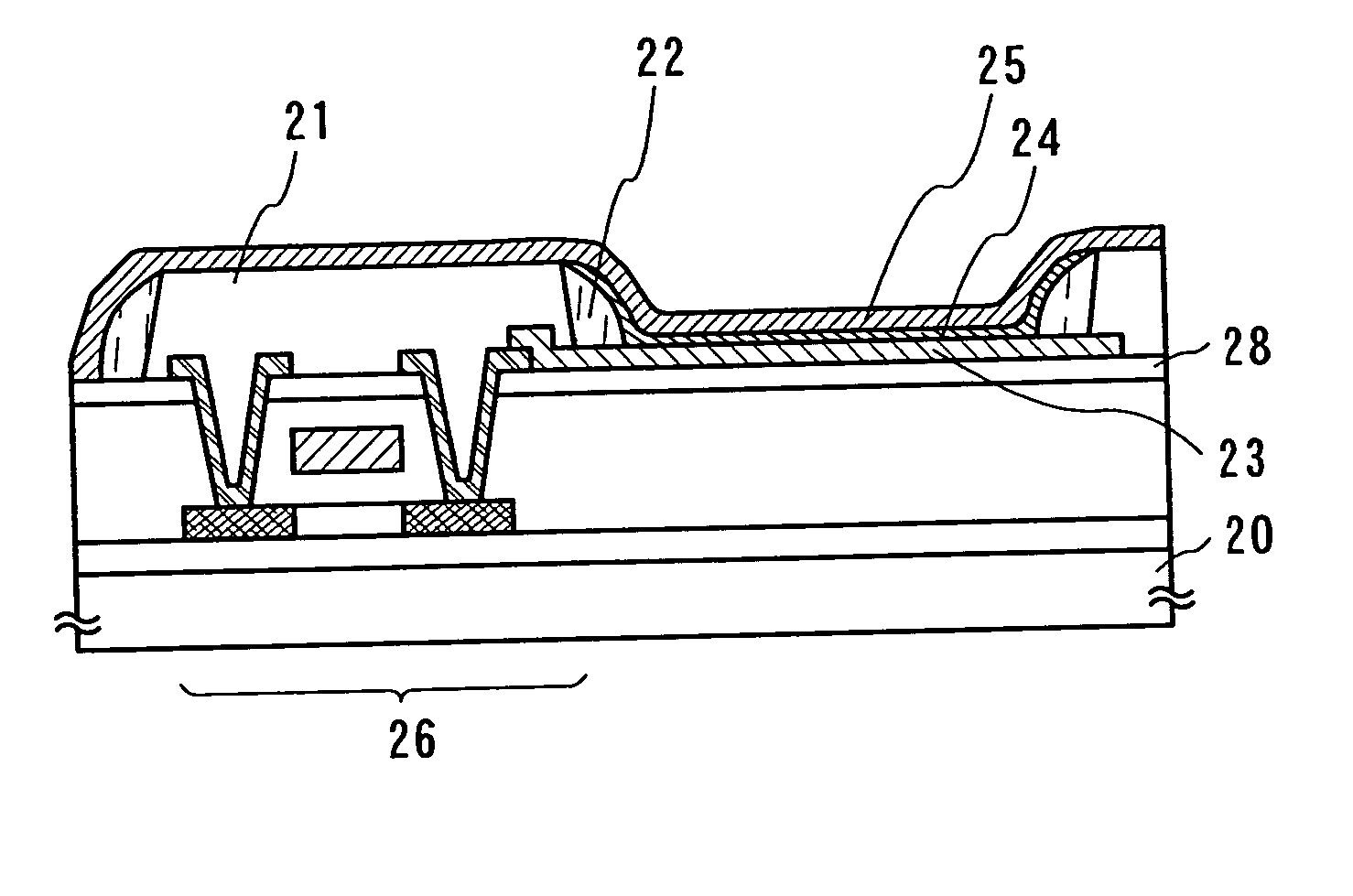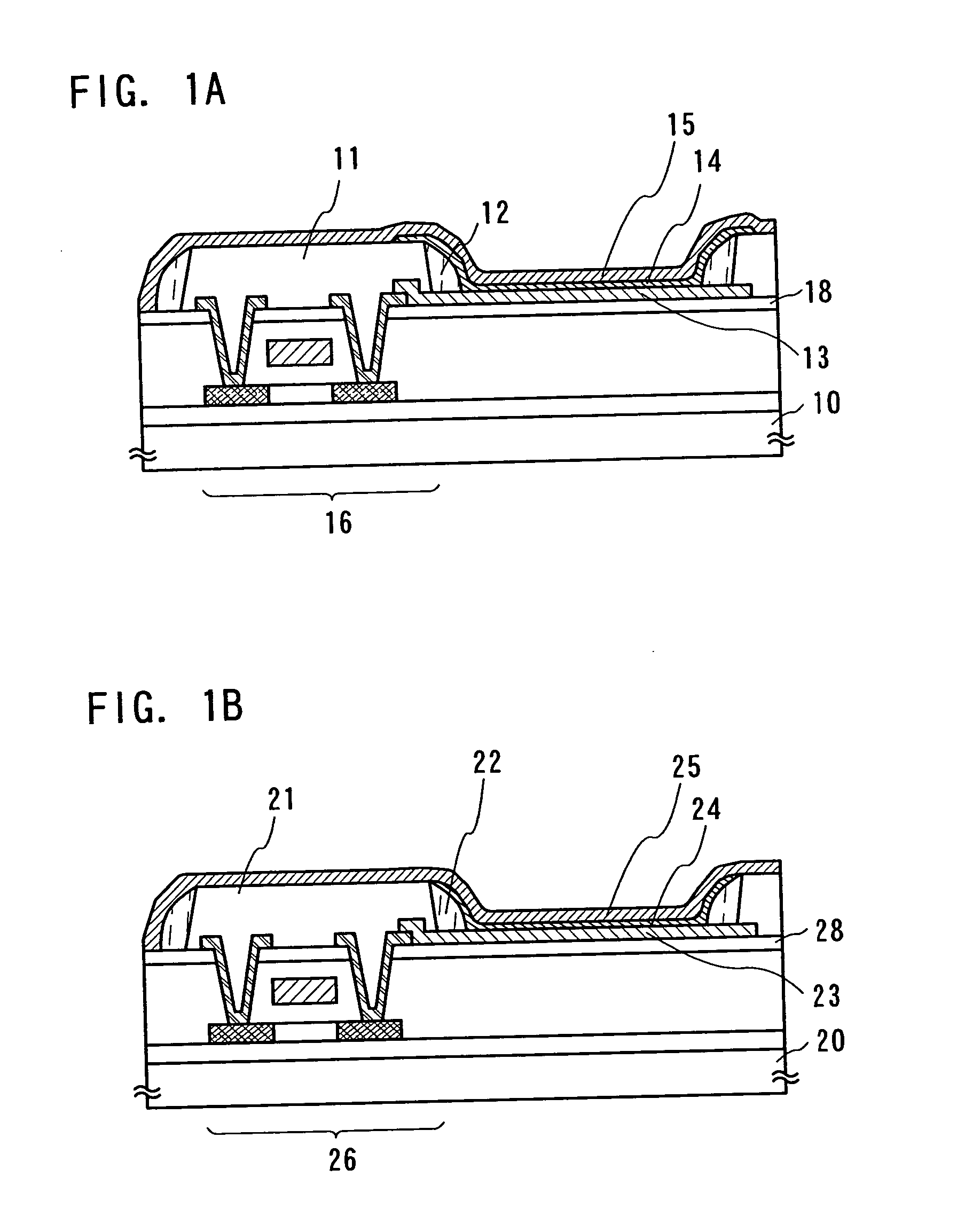Light-emitting apparatus and fabrication method of the same
a technology of light-emitting apparatus and fabrication method, which is applied in the manufacture of electric discharge tubes/lamps, discharge tubes luminescnet screens, electrode systems, etc., can solve the problems of easy damage to the electrostatic discharge surface, threat of dust adhesion to the charged surface or generating electrostatic discharge, and poor coverage. , to achieve the effect of preventing electrostatic discharge damag
- Summary
- Abstract
- Description
- Claims
- Application Information
AI Technical Summary
Benefits of technology
Problems solved by technology
Method used
Image
Examples
embodiment
[0065] Embodiment Mode 1
[0066] The present invention is described by using an example of an active matrix light-emitting device in this embodiment mode.
[0067] In FIG. 1A, reference numeral 10 is a substrate, 11 is a first bank, 12 is a second bank, 13 is a first electrode, 14 is an organic compound layer, 15 is a second electrode, 16 is a TFT, and 18 is an insulating film. In FIG. 1A, the electrode 13 serves as an anode of a light-emitting device and the second electrode serves as a cathode of the light-emitting device, but not exclusively, the first electrode can serve as a cathode and the second electrode can serve as an anode if materials are selected appropriately.
[0068] An example of fabrication process for forming a structure illustrated in FIG. 1A is shown in FIGS. 2A, 2B, 2C and 2D.
[0069] The TFT 16 is fabricated over the substrate 10 having an insulating surface. As materials for an interlayer insulating film of the TFT, for example, inorganic materials formed by sputter...
embodiment 1
[0190] Embodiment 1
[0191]FIGS. 8A and 8B show an example of fabricating a light-emitting apparatus (having a top emitting structure) that includes a light-emitting device having an organic compound layer as a light-emitting layer over a substrate having an insulating surface.
[0192]FIG. 8A is a top view showing the light-emitting apparatus, and FIG. 8B is a cross-sectional view taken along the line A-A′ of FIG. 8A. Reference numeral 1101 indicat d by the dotted line is a source signal line drive circuit; 1102 is a pixel portion; and 1103 is a gate signal line drive circuit. Further, reference numeral 1104 is a transparent sealing substrate; 1105 is a first sealant; and 1107 is a transparent second sealant. An inside area surrounded by the first sealant 1105 is filled with the transparent second sealant 1107. The first sealant 1105 contains a gap material for spacing out the sealing substrate 1104 and the substrate 1110.
[0193] Reference numeral 1108 is a connection wiring for transm...
embodiment 2
[0220] Embodiment 2
[0221] In this embodiment, an example of fabricating such a device that has various functions of materials and a division of function within a lamination structure for improving the mobility of carriers presenting in an organic compound film by relaxation of an energy barrier will be described.
[0222] The technique of inserting a carrier injection layer contributes with respect to the relaxation of the energy barrier in the lamination structure. That is, by inserting a material that relaxes the energy barrier into an interface between the lamination structure having a large energy barrier, the energy barrier can be designed in a staircase pattern. Consequently, a carrier injection property from the electrode can be improved and a driving voltage can be reduced to a certain extent. However, a problem is caused that the number of organic interfaces is increased with increasing the number of layers. That is the reason why a single layer structure rather holds top dat...
PUM
 Login to View More
Login to View More Abstract
Description
Claims
Application Information
 Login to View More
Login to View More - R&D
- Intellectual Property
- Life Sciences
- Materials
- Tech Scout
- Unparalleled Data Quality
- Higher Quality Content
- 60% Fewer Hallucinations
Browse by: Latest US Patents, China's latest patents, Technical Efficacy Thesaurus, Application Domain, Technology Topic, Popular Technical Reports.
© 2025 PatSnap. All rights reserved.Legal|Privacy policy|Modern Slavery Act Transparency Statement|Sitemap|About US| Contact US: help@patsnap.com



